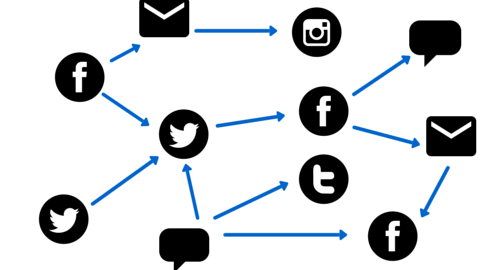October 3, 2016
All too often, social media marketing involves flying blind. You might see in your Google Analytics reports that the social networks are steadily referring traffic to your site, and those visitors might even be converting reasonably well, but that’s just part of the picture, isn’t it? Clickthroughs from many social media mobile apps will appear as unknown sources in your Analytics account, and regardless, Analytics isn’t capable of tracking individual user journeys towards conversion over time, journeys which often involve dozens of touchpoints.
Closing your social media marketing attribution gaps can improve your conversions and cut your costs significantly. According to recent data from Forrester, optimizing your attribution models over time can reduce costs per action by 30% to 50% and increase ROI by 50% to 100%.

Essentially, attribution is what allows you to optimize and hone your strategies by matching conversions to their causes. When you’re able to attribute accurately, you know what tactics, posts and creative iterations are performing the best for you. You know whom to target, how, where and when. Under-thinking your attribution solutions, on the other hand, leaves you dangerously oblivious to what’s working and what isn’t. Doing it incorrectly or oversimplifying attribution can lead you to make costly and fruitless investments in the wrong places.
Audience members rarely convert into customers on their first visits to your site, so if you think someone was convinced to place an order simply because they clicked on one of your Facebook posts a few minutes before they forked over their credit card details, you could probably benefit from a more sophisticated attribution model.
Let’s take a look at some of the attribution models that social media marketers use most, followed by some tools that can help you improve the way you handle attribution.
Social Media Attribution Models to Avoid
- Last Click/Last Interaction Attribution – Using this model, the last interaction or click is given credit for conversions. You get none of the info on what interactions took place before your prospect converted, and you’re not sure how each channel is performing as a result.
- Last Non-Direct Click Attribution – This model is based on the idea that it’s better to give credit to the campaigns that took your prospect to your site their last visit if they convert on this one. It doesn’t capture the chain of interactions that brought the prospect to you and can misattribute as a result.
- First Interaction/First Click Attribution – This model attributes the first interaction a customer ever had with your site or content. Unfortunately, that doesn’t tell you anything about how they interacted with your brand between their first visit and their conversion, or the value of any of those interactions.
Social Media Attribution Models to Use
- Linear Attribution – This is a way of giving credit to every touchpoint before the sale – but it doesn’t tell you who deserves more of it. A little flawed, but at least you have a rough idea what interactions the customer had with your brand before converting.
- Time Decay Attribution – Here you can avoid the pitfalls of under-attributing or over-attributing any given interaction. Using this model, you can give each step of the process a little credit, but the first visit gets a little less credit than the next visit, and so on, all of which get less credit than the actual conversion.
- Customized Attribution – Write your own formula to adjust the weight of each interaction your lead has with your brand before converting. This is a modified version of the time decay attribution model, and if you don’t really know what you’re doing, using it won’t help you. Use this once you’ve gotten some more experience with attribution.
6 Tools for Better Marketing Attribution
Ready to find out how well your content is really performing? That’s a complex task. Basic tools like Twitter Analytics and Google Analytics may provide some useful attribution information, but if you’re interested in useful insights that take more factors into account, you may want to look deeper.
Consider the amount of data you’ll be dealing with and the number of data sources you’ll want to reference. If you don’t use a tool or two to help you manage it all, you may find yourself unable to efficiently learn what you’ve set out to learn. Here are some apps and platforms that can help.
Consolidate Attribution Signals with Segment
Gathering data from every customer touch point and sending it wherever you need it, Segment is a powerful tool and a great asset for any marketing team that’s starting to think seriously about attribution. Trusted by Crate & Barrel, Reuters, intuit, and many other major companies, it also works well for small businesses. If you’re nervous about trying a new tool, you can try Segment for free.

Marketers will likely be especially interested in the tool’s ability to integrate directly with Attribution, a web app for multi-touch tracking and customer acquisition cost analysis, as well as Convertro and TUNE. Segment’s developer-friendly nature allows it to work beautifully with most attribution dashboards and models. Don’t worry if you don’t code, though – you can tinker with the code if you want to, but you don’t need to in order to use it. Although Segment was initially designed to help businesses send data wherever they need it, this is a smart pick for getting started with sophisticated social media marketing attribution.
Segment is especially useful to marketers working with multiple types of paid social posts. Compared to display advertising, sponsored social posting is a relatively new media type, and as a result, not overly saturated. Less competition, greater exposure, and excellent ROI are great reasons why today’s marketers are turning to paid social, which only highlights the greater demand for viable attribution solutions.
Track Influencer Shares with Start A Fire
Used by brands including HubSpot, CB Insights and Sequoia Capital, Start A Fire was invite-only until recently. Now you can get an account in under 30 seconds. This tool serves the dual purposes of growing your reach and helping you keep track of how your content spreads across channels.
Start A Fire lets you share content assets that your readers will be most likely to love – and keep your brand associated with the content, even if it’s published by someone else. It works by adding a “branded badge” to the pages people see when they click through from your Start A Fire-enabled shares.

This URL shortener also offers plenty of rich metrics, so you can track views on your shares, even when they’re reshared by others. If you were to tweet a link to a New York Times article, for example, and someone retweets it, then your brand does get a certain amount of extra exposure, but that benefit doesn’t last very long, because audience members won’t necessarily associate you with the content. But if you share Start A Fire URLs instead, your badge goes wherever your URL does, and you can track all associated page views, badge views and badge clicks.
Track Your Mobile App’s Interactions with AppsFlyer
Designed to work with paid social posts and other ad media for the purposes of driving mobile app installs, AppsFlyer gives you real-time data on a host of important metrics – clicks, organic vs. nonorganic installs, revenue, average revenue per user, even custom in-app metrics to help you track interactions after app installs (booking a hotel room or building a shopping list, for example).

There’s a 30-day free trial available if you’d like to play with the software a bit before committing. Current users include HBO, Macy’s, The Wall Street Journal and Samsung. Thanks to the tool’s extensive mobile analytics and attribution-centered focus, you can easily track a full suite of attribution metrics from an attractively designed dashboard.
AppsFlyer works well with all attribution models. Get a more complete understanding of your mobile marketing ROI and present clear results that highlight areas you can improve your social media performance – and ensure you’re investing the most where you’re most likely to profit over time.
Track Content Performance with Lead Ferry
Ideal for brands that invest heavily in distributing content via their social channels, Lead Ferry helps you track the conversion funnel performance of your content by channel. Find out the number of unique visitors, leads generated, customers generated, and get your content’s engagement score.
You can track individual goals or overall performance, and invest your paid content spend on platforms that actually build your customer base. A free plan is available for sites with less than 100,000 monthly visitors.

Marketers will enjoy the tool’s UTM tagging features to help with attribution, as well as Lead Ferry’s overall versatility. It pairs particularly well with last-touch attribution models, but it can adapt to other models as well. Because it’s designed for tracking the revenue performance of your content funnel, this tool can give you the data you need to make sure you know what pages to promote on which social channels.
Follow Your Visitor’s Mouse with ClickMeter
ClickMeter offers more than 100 features to assist marketers with marketing attribution and analytics. This software is fully integrated with social media and is developer friendly, playing nicely with everything from AdWords to SandBox.
The maps and reports it creates provide detailed insights on your audience (including click streams – i.e. what people are clicking on while on your site). You can turn any URL into a short tracking link for easy sharing on Twitter and other social channels and to keep an eye on where and how your content spreads on social media and beyond.

The tool is fully scalable and boasts 99.99% uptime, making it a reliable choice to help you keep the attribution data flowing at all hours. ClickMeter works well with the attribution model of your choice, including custom models.
Know Who’s Clicking Through with Clk.im
Clk.im-shortened URLs can provide a whole host of metrics on who’s clicking on your social posts, revealing their geographic locations, devices, platforms, browsers, OS, language settings, and more so you can hone in on your audience and build rich personas based on real data.
The tool also uses pixels to track conversions, run targeted campaigns with QR codes, and try A/B testing your URLs. Clk.im helps take the headache out of these complex yet powerful social media marketing tasks, so you can track the effectiveness of your strategy and tweak it accordingly.

Find out how your links are performing in real time and get a report daily in your email. The result is social content promotion that is easy to keep track of and attribute – no matter how far it spreads or what attribution model you’re using.
Conclusion
Finding out how your social media activity performs is crucial. You need to know how your posts are received, where your ad spend is going, which channels are performing the best, and who’s engaging.
Thanks to the wealth of marketing attribution tools available, you can finally understand your social ROI, improve it by refocusing your emphasis on the most lucrative communities, tweak your targeting efforts, improve conversions, and show stakeholders enough data to prove your point. From Start A Fire to Clk.im, the tools listed above make it that much easier to extend your reach and track your audience interactions and conversions.
Digital & Social Articles on Business 2 Community(44)






